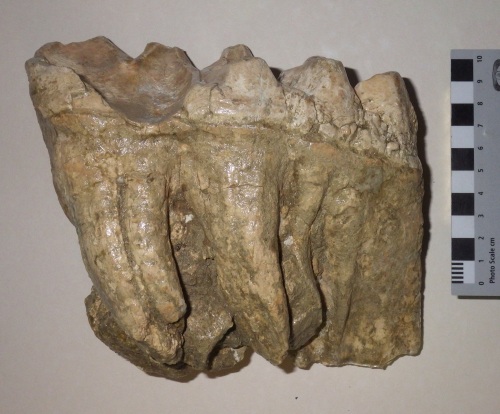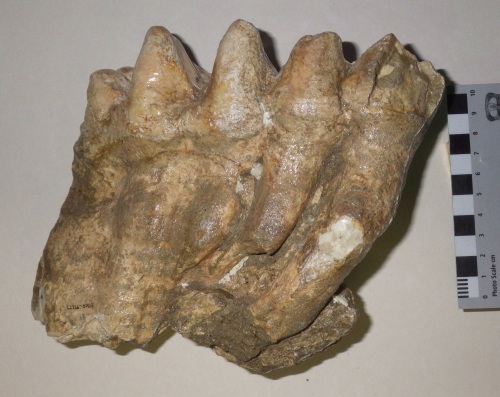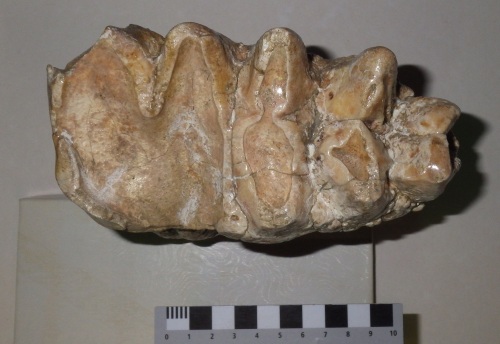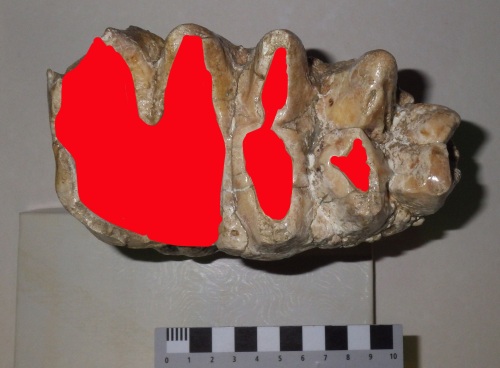For this week’s Fossil Friday we have a tooth from this blog’s namesake, the mastodon Mammut americanum. This particular tooth was collected about 15 miles southwest of the museum, not far from Temecula in Riverside County.
This tooth is the lower left 3rd molar. The image above is the side, or lateral view, often referred to in teeth as the labial view (literally “near the lips”). The front of the tooth is to the left, and a lot of wear is visible on the crown at the anterior edge. Below is the same tooth in medial, or lingual view (literally, “near the tongue”):
In this view the front of the tooth is to the right, and the wear is much less obvious. The discrepancy in wear between the lingual and labial sides of the tooth are even more obvious when looking at the chewing surface of the tooth (occlusal view):
The front of the tooth is to the left. Mastodon teeth have enamel cusps arranged into a series of transverse ridges. There are five of them on this tooth. The first ridge is almost completely worn away, especially on the labial side where the enamel is completely gone. The second ridge is also heavily worn. The third and fourth ridges show moderate wear, with only the top of the enamel ridges worn away, while the small fifth ridge has very little wear. In occlusal view an unworn mastodon tooth is completely covered in enamel, but as the tooth is used the enamel wears away, exposing the softer underlying dentine. In the image below the dentine is colored red, giving an idea of how much enamel has been lost:
There are a few things that we can say about this mastodon based on the variations in wear patterns across this tooth. Because of the way mastodon teeth occlude when the mouth is closed, it’s not unusual for the labial side of the lower teeth to wear more rapidly that the lingual side. The upper teeth usually show the reverse, with heavier wear initially on the lingual side. In both the upper and lower jaws the teeth eventually wear down until are essentially flat, but his tooth never reached that level of wear.
The difference in wear across the tooth from the front to back is a result of the unusual method of tooth replacement in elephants and many other proboscideans, including mammoths and mastodons. Instead of having a mouthful of teeth all at once, mastodons grow in their teeth gradually and sequentially. As a tooth wears down, it moves forward in the jaw, eventually falling out and being replaced by the next tooth in the sequence. Since an individual tooth moves into position gradually, the front part of the tooth starts wearing down before the back part of the tooth has erupted. That’s what we see in this tooth, in which the first enamel ridge is almost completely worn away while the last enamel ridge has almost no wear at all.
Because of the sequential tooth replacement, we can also say a little about the age of this mastodon when it died. This tooth is the 3rd molar, which is the last one in the sequence, and it shows only a moderate amount of wear. This suggests that this mastodon was a fully mature adult, but not elderly, when it died. In modern elephants the 3rd molar doesn’t erupt and begin to wear until the animal is about 25-30 years old. Assuming mastodon growth and tooth replacement rates were comparable to living elephants, this mastodon would likely have been 30-40 years old when it died.






